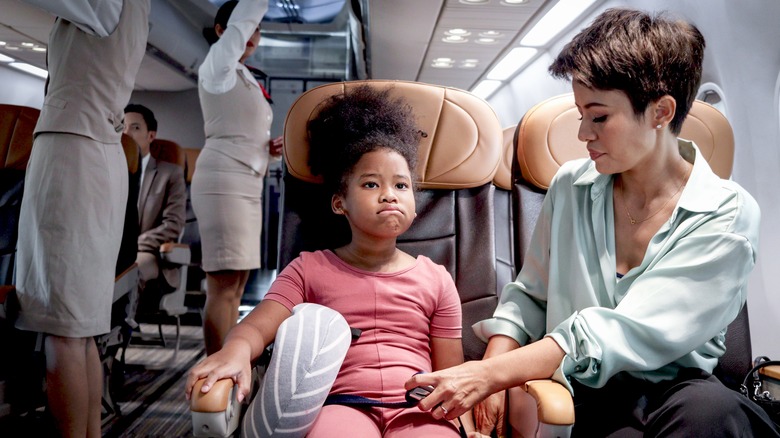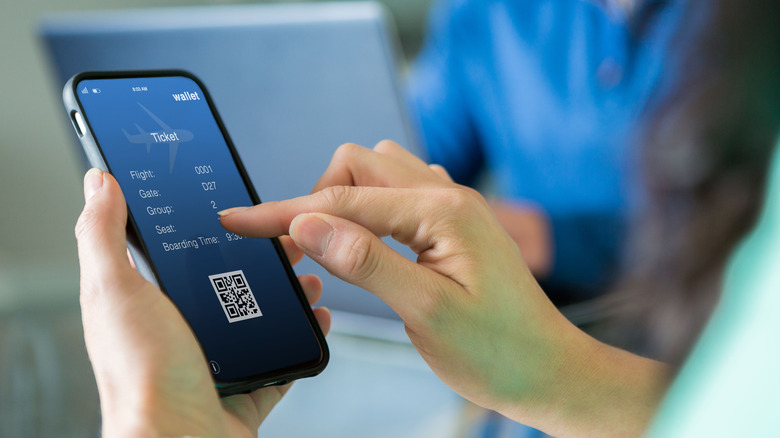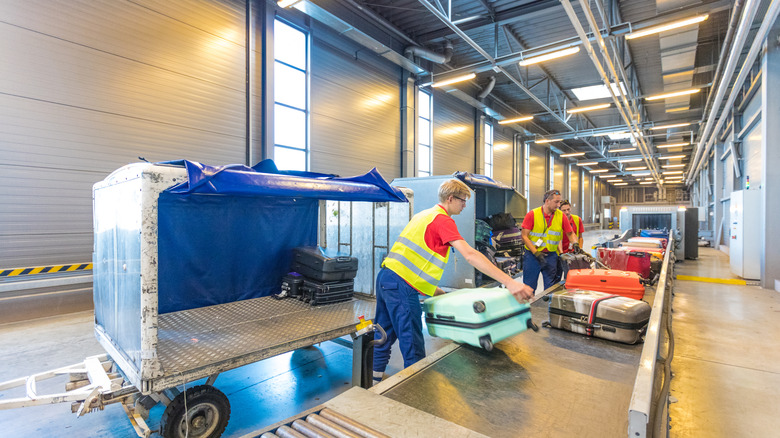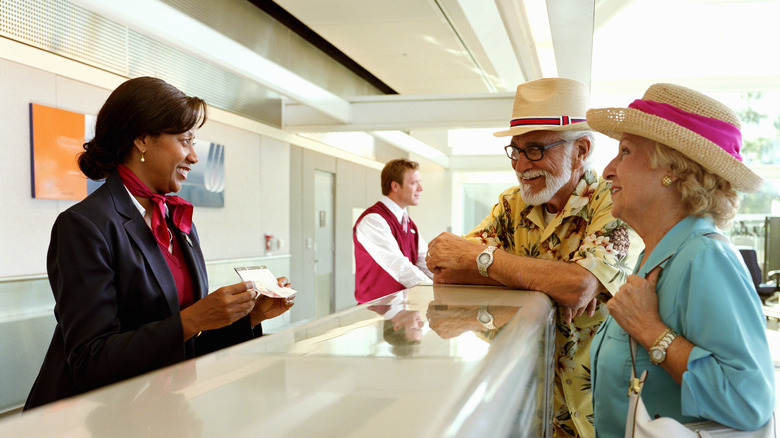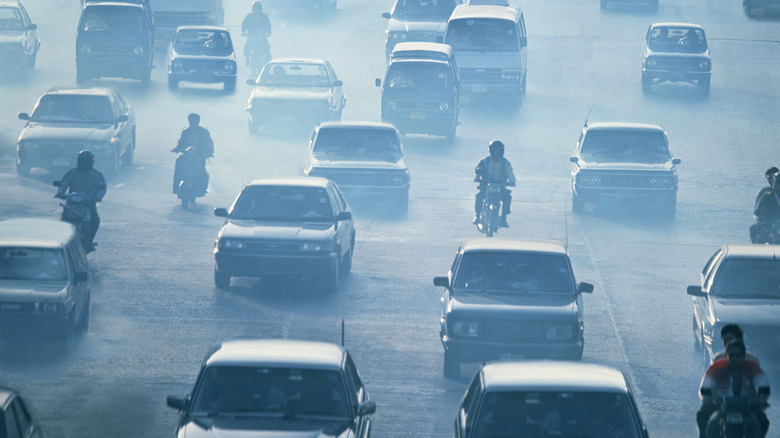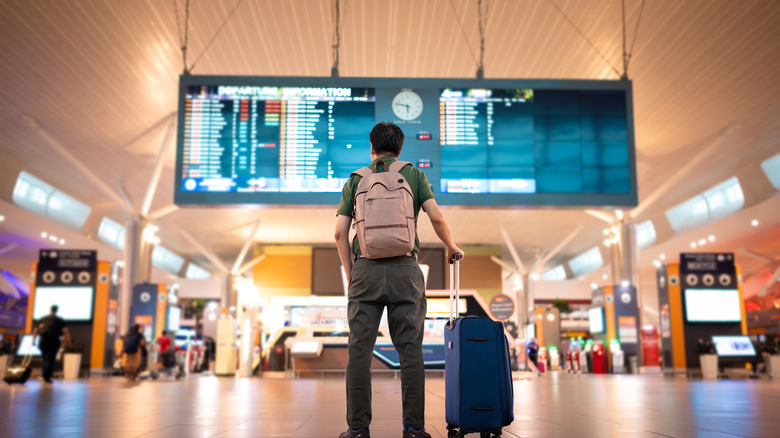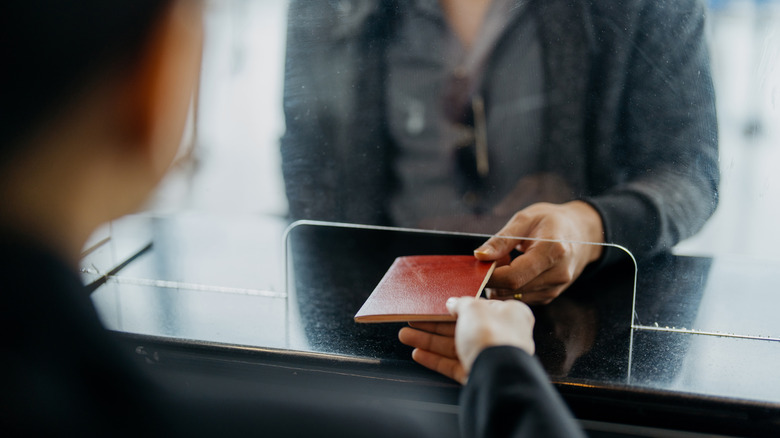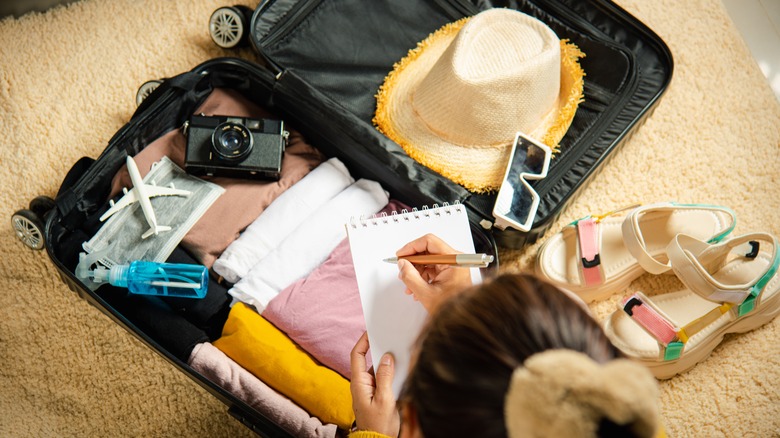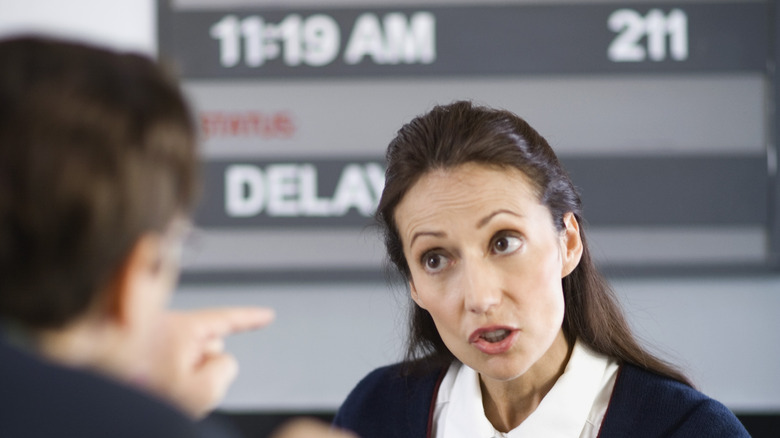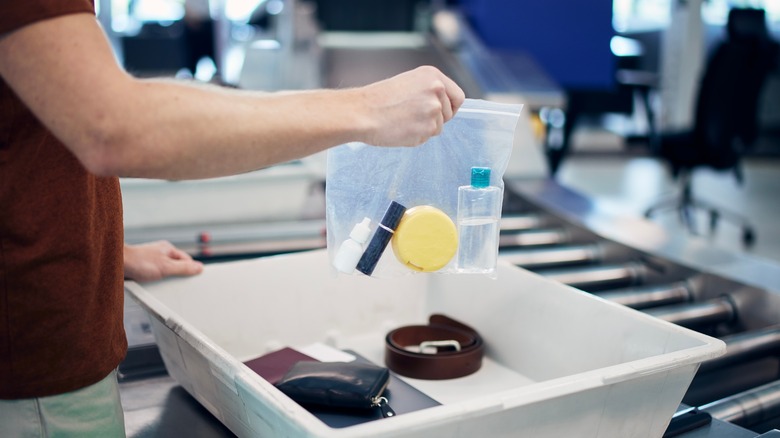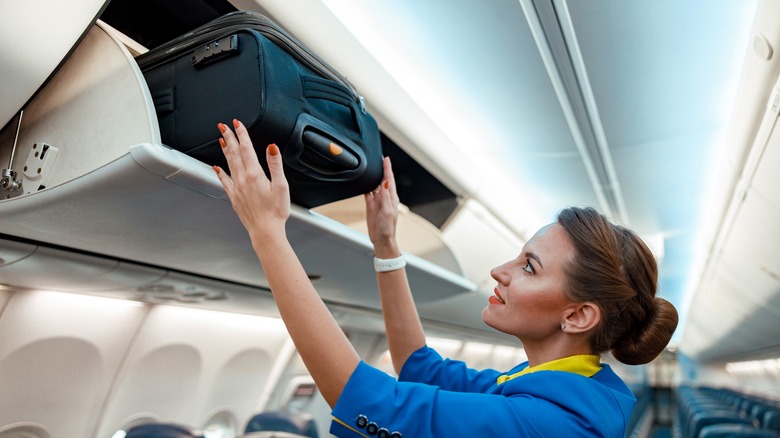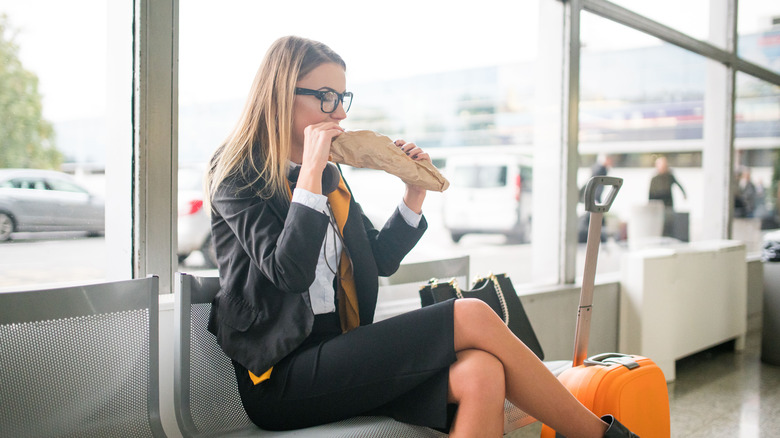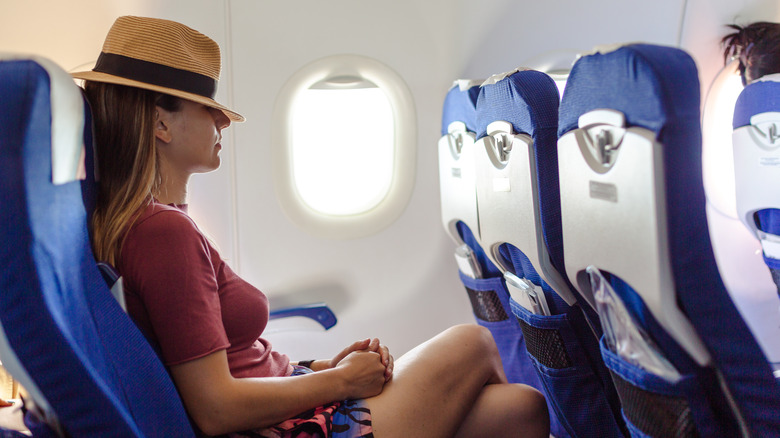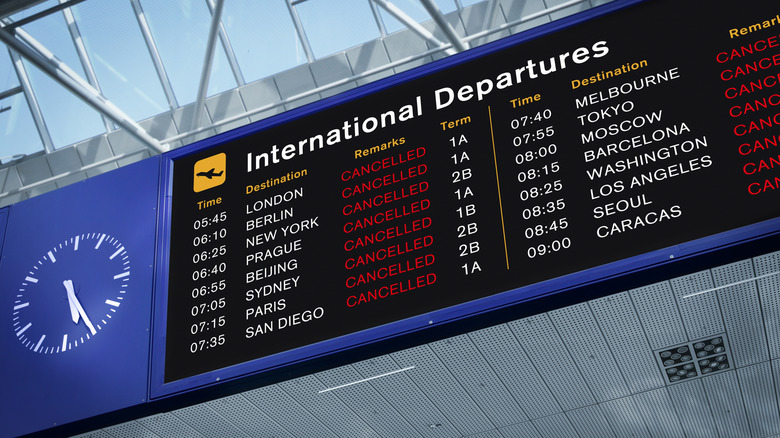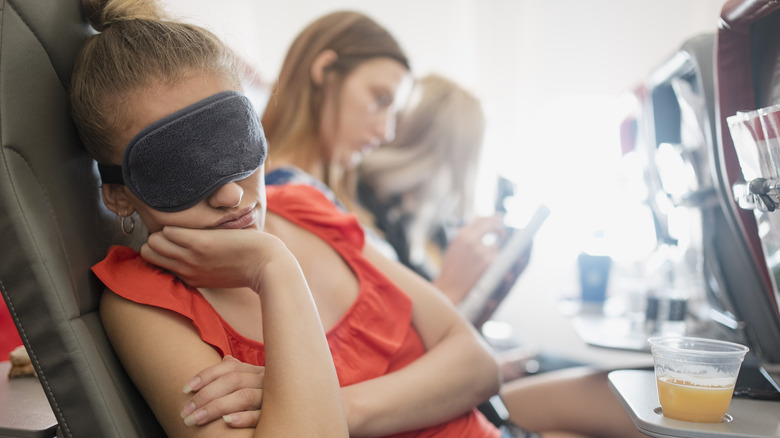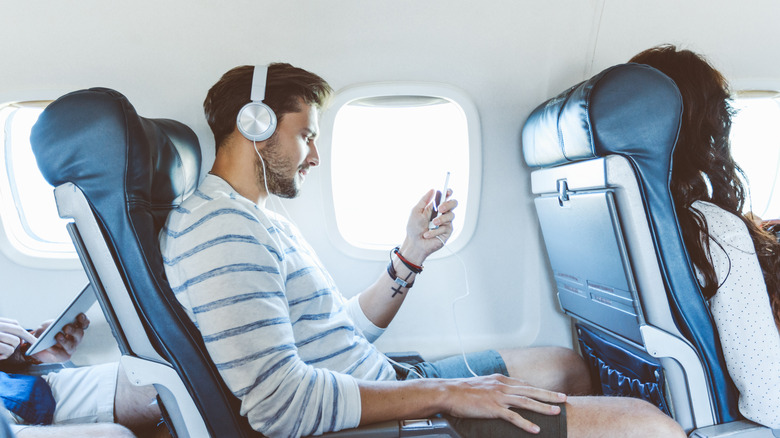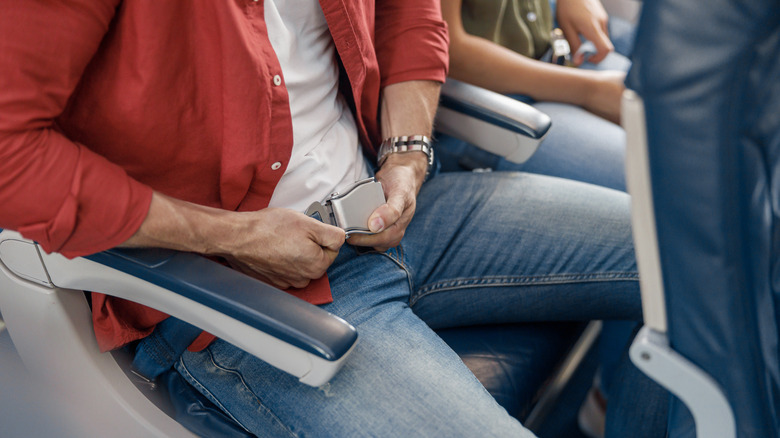Don't Make These Rookie Mistakes As A First-Time Flier
A lot of people fly, and every year, millions of them do it for the first time. Whether it's a young child making their maiden voyage on a plane or an adult in their later decades who's decided to take the leap, travelers of all sorts fly the skies as newbies day in and day out. Air travel is a daunting prospect even for seasoned fliers, but for first-timers, it can be a terrifying experience, full of strange procedures, novel sensations, and stern people.
From the repetitive rows of check-in desks at the terminal to the confounding choreography of security screening, embarking on your first flight can be a puzzling process. It doesn't have to be to, and, as with anything new, there are things to learn that can demystify the process, tricks and tips that habitual travelers know as second nature. Use a few, and it will make your airborne debut a smooth, hassle-free, painless undertaking.
Booking near your travel date
After days, weeks, or even years of contemplating, you've finally decided to take your first flight. Now comes the hard part — where you'll go and when. While the first bit is important, there are really no wrong places to fly, so let's skip that. The second part, however, can have a real consequence on your inaugural trip. Scoring a cheap flight is the holy grail of air travel, and while it's not always possible, it's certainly more realistic if you plan ahead. Way, way ahead — we are talking months in advance.
Flight bookings are usually cheaper if you make them any time from 45 days to six months in advance when supply is often plentiful and demand still slack. Don't leave it till the last minute, when prices have an annoying tendency to keep climbing (blame the old supply and demand relationship again for that). Also, flying mid-week is generally cheaper than on the weekends, so try to book accordingly where possible.
Not purchasing baggage in advance
Sadly, long gone are the days when luggage was included in the price of every booking for trips on the larger airlines (budget airlines were never so generous). Now, passengers choosing the most basic class of ticket on a flight are limited to carry-on baggage as their only freebie. Some airlines let you purchase additional baggage in advance, and if that is an option for your first flight, choose it at the time of booking. Purchasing that baggage allowance beforehand can be cheaper than paying for the same bag at the airport, especially with budget airlines.
Another benefit is that it will save you time at the airport since you will not need to join the general check-in line but the bag-drop line, which is often shorter and quicker. Try to bring a suitcase that can be easy to identify, that stands out, and will be quick to spot on a baggage carousel. One easy travel tip to help you distinguish it from the sea of other cases sliding by on the baggage belt is to put an accent or accessory on it. Popular choices are travel stickers, a bright ribbon wrapped around the handle, or a long piece of string or a strap tied around the bag's torso.
Waiting to check in at the airport
Once upon a time, not too many years ago, checking in required passengers to go to the airport hours before the flight to stand in a snaking, slow-moving line at a terminal desk, where an airline agent would check their documents and physically check them in, and issue them their boarding pass. With the advent of the internet, that process has become much quicker and easier, and now passengers can check in online, sometimes up to 48 hours before the flight departure. We recommend that you check in online as soon as you can — policies vary between airlines, though 24 hours before the flight is a fairly dependable benchmark.
Sometimes, during online check-in, you can choose the seat for your flight without having to pay a fee (another thing that used to be free before airlines began to nickel and dime every flier). If the flight is overbooked, as many are these days, your chances of getting bumped off involuntarily are much slimmer the earlier you check in. As with most things in life, it is best not to dilly-dally.
Driving to the airport when you can take public transport
Road travel in your car to the airport is undoubtedly the most convenient option. There's no denying the ease of taking your own vehicle if you have lots of bulky luggage, loading it up at home right from your front door before scooting off. But travel by car is at the mercy of sudden, unforeseen traffic snarls, which are completely out of your control. On the other end, airport parking can be pricey.
Long-term parking lots are cheaper than those near the terminal, but they usually require a long shuttle bus ride to the actual departure point, adding an extra leg to the journey. Be smart, and take public transport to the airport where possible, especially if you can do so via a subway or rail system, which will never be caught in road traffic jams. Not only can public transport be quick, but it's usually cheaper than the cost of driving your car and parking (and it's definitely cheaper than a taxi). It's also better for the environment than a private transfer.
Not getting to the airport on time
Airlines have strict cut-off times for checking in, dropping your luggage, and being at the gate. Getting your suitcase from the check-in or bag-drop counter to the cargo hold of your flight is a complex, time-consuming business that entails scanning luggage, security checks, and holding it until it's ready to be loaded onto carts and pallets for the plane. A terminal at a large international airport will process many thousands of passengers every day, and every single one needs to have their documents checked, bags screened, and make their way to the correct gate.
Lots can go wrong. Mostly, things don't, and time is one reason why. Passengers need to leave themselves ample time to get to their counters, security, and gates. This is why you should arrive at the airport at least two hours before a domestic flight and three hours before an international flight.
Bringing the wrong ID
For domestic flights within the U.S., a passenger only needs to carry a state-issued ID to identify themselves to the airport and airline staff. And, as of May 2025, that will need to be a Real ID to board a flight. A Real ID looks similar to the standard identification document issued by the state but has some enhanced features and is accepted throughout the country as a form of ID. Some years ago, driving licenses were sufficient establishers of identity to board flights to Canada, Mexico, and some parts of the Caribbean, but now American fliers need a passport to travel internationally, anywhere. That change might account for the rapid rise of passports issued by the Department of State, growing from about 7.3 million in 2000 to more than 24 million in 2023.
As stated by the Department of State's Travel account on X, formerly known as Twitter, almost 50% of Americans have a passport today, compared with 30% in 2008. Make sure to carry the appropriate travel document, depending on where you are flying. For passports, also check the expiration date — many countries won't allow you in if your passport expires less than six months from the date of entry or exit to that country. It is also vital to know if you need a visa.
Packing banned items
Putting together the items you'll need for your trip can be confusing enough. Two pairs of shorts or three? Smart shoes and casual shoes, or a pair that can play the role of both? A rain jacket and a heavy coat, or just the latter and a sturdy umbrella? Sartorial choices are a matter of personal and practical preference, but there are certain items that you can never pack in your suitcase, whether you want to or not. The TSA clearly outlines which items can and can't be checked in, and that information is listed on its website. The list is comprehensive, some may say exhaustive, but it certainly leaves no room for ambiguity.
Check the TSA site, and you'll find that deer antlers can be checked in, but chlorine never can, nor can alcohol that is over a certain level of proof. A thermometer with mercury is banned from check-in luggage, but is permitted in carry-on under certain circumstances. We could go on, but you get the point. Pay attention and follow the rules.
Being rude to airport employees
A check-in counter employee usually doesn't work for the airline (they are contracted ground operators) and has no say on when the plane will leave or why your preferred seat isn't available. Please don't get annoyed at them for things that are out of their control and pieces of your journey that they don't have the power or authority to change. Just because you have purchased a ticket to fly on one of the airline's aircraft, you shouldn't feel entitled or feel like the airline's employees are there to serve you.
It's important to treat workers (and fellow passengers, some of whom will be first-time fliers like you) at the airport with respect, kindness, and patience. They are just doing their jobs to the best of their abilities, and it is important to be mindful of this at all times. It's also a criminal offense to threaten, abuse, or assault a TSA agent, and fines and jail time can be the punishment if you are convicted.
Ignoring the liquid rules
Just as there are strict guidelines for what you can check into your suitcase, there are rules on the items you can pack in your carry-on bag. Perhaps the most well-known of these is the liquid rule, which was introduced in 2006. It was launched to ensure that fliers couldn't bring enough liquids on board that could be used to power an explosive device. With this rule, passengers are limited to bringing liquids (like creams, toothpaste, and contact lens solution) in containers that are (individually) no more voluminous than 100ml or 3.4 fluid ounces. The containers holding the liquids must fit into a clear plastic quart-size bag.
If you bring more than this amount, you will have to dispose of the liquid or risk having the bottle thrown out. As part of the screening process, fliers also have to separate their laptops, tablets, and other electronics before going through security. It is wise to have these handy and easily accessible at the screening point to save everyone a little bit of time. And wear shoes that are easy to take off, as you may have to remove them as well.
Trying to smuggle a big bag onboard
As well as liquids, bags also come with size restrictions. This pertains to both those you check in and those you will bring into the cabin. Airlines will typically have a small mock-up frame of the dimensions of this overhead bin near the check-in or bag-drop counter, and you can ascertain whether you can squeeze your bag into the space there and then. Some passengers ignore that minor detail and try to smuggle a bag far too big to fit anywhere in the cabin, only to run into problems at boarding.
Airline staff are trained to spot oversized bags at the gate and will often ask the passenger to check in the bag before boarding the flight. Though there is not always a charge for this, it is inconvenient, as the bag will have to be collected from the baggage carousel at the other end. Be smart, and travel with the right size carry-on bag — you can establish the exact dimensions on any airline's website.
Eating at the airport
If you thought about the best restaurant meals you've ever enjoyed, chances are none of them would be at an airport. Airport food is limited, not usually fresh, and wildly overpriced, and there are many reasons for this. Airports are generally located far from the center of the city, and the logistics of getting the food to them is expensive and time-consuming — the goods have to be transported to the remote location and then must pass through security screening.
The distance also means that staff need to travel out there, and businesses will need to pay higher salaries to attract workers. Since airports have limited space and plenty of foot traffic, they are also considered premium locations for retail, which means rents are high. The space limitations also ensure that competition is limited, so the higher rental costs can easily be passed on to a customer with little in the way of choice. So, avoid airport food if you can — it is better to bring your own. Just make sure you can take the feast through security.
Not stretching your legs before your flight
Unless you have the funds to spring for a business-class seat, you'll find that the seating set-up on the aircraft is pretty cramped. The seats are narrow, and there is minimal legroom in front of them. For tall people, the experience can feel like torture, like they are cooped up or caged. While passengers can get out of their seats and walk around during the flight, large portions of any time in the air will require fliers to be firmly sat down with seatbelts fastened. If you have restless legs or are brimming with energy, it can feel like purgatory. Okay, it's not quite purgatory, but it's not very pleasant either.
Help to assuage that discomfort by walking around the terminal before you board, doing some stretches, and ironing out the kinks. It also helps to take a bathroom break in the airport before you board — aircraft toilets are tiny, not always clean, and you may be stuck in a long line waiting for one. And that's not much fun when nature calls.
Expecting everything to run smoothly
A flight is the product of many moving parts, hundreds of little cogs that need to turn together in harmony to produce success. The pilot and cabin crew have to show up on time, check-in staff have to work efficiently at the counter, and security screeners must all show up for their shift to process the number of fliers efficiently. One or many of those things can go wrong — flights get delayed, meals get canceled on a flight, you might end up with a bad seat, or you might get bumped because the flight is overbooked. While all of these things are out of your control, they can completely ruin your flying experience — if you let them.
Go with the flow and try to accept these problems as minor inconveniences. A delayed flight will eventually take off, a bad seat isn't forever, and if you don't get the special meal you requested, there's always the next meal to look forward to. Getting things in perspective will help you to ride out the fleeting episodes of disappointment.
Not hydrating
The cabin of an aircraft is filled with recycled, dry, cold air that saps the water from our bodies. Anyone who has spent time on a plane will remember feeling parched, having dry nasal passages, and taut, scratchy skin. By some estimates, fliers can lose liters of water just by being onboard in that arid air. There is an obvious way to combat this, and that is by drinking lots of water. Depending on the carrier, fliers can get water on a flight served by the cabin crew, but not all flights offer it.
Be prepared and bring an empty water bottle to the airport, and fill it up after security screening. Sip from it regularly throughout the flight, whenever you feel dry in the mouth, or if your head starts to feel heavy (definitely before it starts to pound). There is one problem with drinking lots of water, though, and that is the possible need to dispose of all that agua — get an aisle seat for easy access to the restroom.
Sleeping when you shouldn't
Jet lag is no fun, and sleeping on a flight at the wrong time will only help to amplify it. Arriving at a destination in a different time zone with your body clock all out of whack doesn't only play havoc with your sleep patterns. When your circadian rhythms (which govern digestion) don't jibe with the local time zones, you'll find yourself with gastrointestinal issues. You won't feel hungry around meal times, and the off-kilter processes can cause diarrhea, constipation, and stomach aches. The easiest way to adjust your body clock to your new time zone is to try to synch to it pronto, ideally a few days before the flight.
This isn't always practical — especially if you are traveling halfway across the world, where the night occurs during our daytime, and vice versa. One thing you can always do is get on the flight and immediately change your watch, or phone clock, to the time at the destination. If it's daytime where you are headed, stay awake on the flight; if it's night, try to catch some shut-eye. When you arrive at your final destination, immediately try to slip into local time, which might mean staying awake for many hours, even if you feel sleepy.
Not bringing your own headphones and masks and ear plugs
Even if we have become accustomed to devouring content on our phones or tablets, there's something fun about flicking through the shows, movies, and video games on the in-flight screen. For starters, the films usually include new releases that aren't yet available on any streaming services. In a way, it feels like you are seated in your own private cinema. On these flights, the cabin crew often hand out free headphones, which are usually cheaply made (obviously, since they are disposable) and have bad sound quality.
What you need is noise-canceling headphones, a pair that will drown out the whooshing and whirring and droning sounds of a flight. Bring your own, ones that you know are comfortable and work for you. While you are at it, bring a mask to cover your eyes and earplugs if you plan to sleep onboard.
Belittling the role of the seat belt
Unlike a car seat belt, a plane seat belt is secured by a sturdy, weapons-grade belt buckle that is easy to operate but virtually indestructible. The belt ensures you are tethered to your seat safely when the plane is in motion. There are times during the flight when the aircraft feels like it's weightless, almost floating in the air, when you might feel there is no need to keep the seat belt buckled (especially if the cabin sign requiring them has been switched off). But you should always keep it buckled — the only exception is when you aren't in your seat.
Sudden turbulence and air pockets can bump a plane around with ridiculous ease, and while fliers shouldn't be concerned when the plane rapidly jumps and drops in the air (think of it like a car driving a speed bump or pothole), a flier that is unbuckled can easily get thrown up out of their seat, with injury a possibility. Even if the belt buckle is clunky and can feel constricting, especially over thick clothing (which you should bring since airborne planes are usually on the chilly side), that's a small price to pay for your safety.
